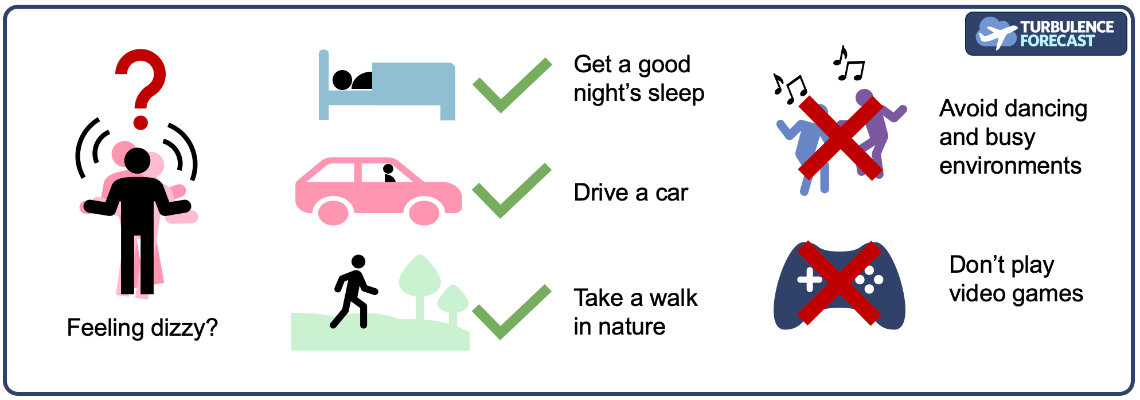Are you an Android developer and love the site? Contact us
updated (Apr 14, 2024)

(c) Turbulence Forecast 2023
Help, everything is wobbly!
Published December 05, 2023
You’ve landed from your long-distance flight across the continent or the globe, and you’ve taken a cab or bus to where you’re staying. Before going on your first exploration, you need a little nap and you check out the bed or the couch. After a couple of minutes of laying down, it starts! You wonder, is this room shaking or swaying? Is there a train running nearby? Why am I dizzy? Am I going nuts? No, you’re not!
The scientific name for this condition is quite descriptive: mal de débarquement (French) or disembarking sickness. Although it was initially named after the experience of passengers traveling on ships, some people also feel it after longer train or plane rides, especially if there was some persistent light or moderate turbulence along the way. Very sensitive people might feel it after jumping on a trampoline or a bumpy car ride. The symptoms include feeling like you’re still moving, although you’re perfectly still. You could sense that you are swaying, rocking, or bobbing when you close your eyes. Most people will never experience this, and others only occasionally. The great majority of cases resolve in a few hours to a couple of days.
The first commercial transatlantic crossing by ship happened in 1838, with the SS Sirius steamship. Another 100 years passed before the first transatlantic commercial flight in 1939, when a Boeing B-314 Yankee Clipper took off from New York and landed in Marseilles in France. Technology has improved greatly, both for ships and for planes, but those early passengers felt a lot more of the ocean waves and also plane movements, and disembarking syndrome was more common.
However, our vestibular system detects even the smallest shifts, and sometimes takes a while to regulate after continued exposure to displacement and movement. The vestibular apparatus is located in the inner ear, and keeps track of the position of our head in space. It’s a crucial element for human functioning: walking, driving, and pretty much everything we do. It’s a very sensitive mechanism and really just tries to help you, by adjusting to the movement of a ship or plane while you’re on it, and it might take awhile to readjust to being on a solid surface.
So what can you do to make it stop? Here are some tips that can help. Note that it can take shorter or longer for different people, and you have to experiment what works best for you. For some of us, this lasts only a few hours, and for others it can be a couple of days.
- Take a slow walk, somewhere you can focus on an open horizon.
- Avoid activities that add more movement and rapid eye and ear stimulation, such as dancing or playing video games, until you feel better.
- Get a good night’s sleep. Most often, in the morning you feel normal again.
- Don’t be surprised if the sensation subsides while you are driving. While you are in motion, you will feel better. Take a few moments to rest and look at the horizon after you stop the car and before you get out.
- Try to relax as much as possible to give your body time to reset to being on land and steady ground.
Even trying all the things on the list, you might still feel some unsteadiness when you’re sitting or laying down. But just as surprising as it was when you first noticed, it will most likely disappear. If you are one of the few people that sometimes have to deal with disembarking sickness, maybe it helps to think about the fun vacation that is in front of you. Being able to get around the world on a plane in a few hours still beats staying home!


